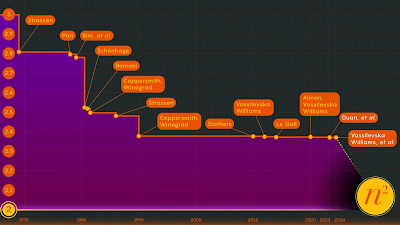For decades, computer scientists have been on a relentless quest to find faster ways to multiply matrices. This seemingly simple mathematical operation, essential for many areas of computer science, has far-reaching implications for our lives. From the graphics on our screens to the artificial intelligence (AI) that powers our devices, matrix multiplication plays a critical role in the speed and efficiency of these technologies.
The traditional method for matrix multiplication takes n^3 steps, which can be excruciatingly slow for large matrices. Imagine the time it would take to multiply two matrices containing millions of entries! Over the years, researchers have made incremental improvements to this method, but a significant breakthrough arrived with the introduction of the "laser method."
While the laser method itself is not practical for real-world applications, it provided valuable insights into the problem of matrix multiplication. In 2023, researchers Duan, Zhou, and Wu were able to identify a hidden inefficiency lurking within the laser method. This discovery proved to be a game-changer. By eliminating this inefficiency, they were able to improve the upper bound for omega, a measure of how fast matrix multiplication can be done, to 2.371866. This represents the most significant improvement in decades and brings us closer to the ideal of multiplying matrices in significantly fewer steps.
The Significance of Faster Matrix Multiplication
The quest for faster matrix multiplication algorithms is not merely an academic pursuit. It has real-world consequences for many fields that rely on large-scale computations. Here's how a breakthrough in this area can impact various aspects of our lives:
- Revolutionizing Machine Learning and Artificial Intelligence: At the heart of many machine learning algorithms, including deep learning, lies matrix multiplication. These algorithms are the driving force behind advancements in image and speech recognition, natural language processing, and recommender systems. Faster matrix multiplication methods could significantly improve the speed and accuracy of these algorithms. Imagine AI systems that can learn and adapt even faster, leading to more intelligent virtual assistants, more realistic chatbots, and more powerful tools for scientific discovery.
- Accelerating Computer Graphics and Image Processing: Matrix multiplication plays a crucial role in various graphics and image processing tasks, such as image filtering, 3D rendering, and computer vision. Faster matrix multiplication could accelerate these processes, leading to more realistic and immersive graphics experiences. For instance, it could pave the way for real-time ray tracing in video games, creating environments that are indistinguishable from reality. In the field of medical imaging, faster processing could enable doctors to analyze complex scans more quickly and accurately, potentially leading to earlier diagnoses and better patient outcomes.
- Boosting Scientific Computing: Many scientific simulations and computations rely heavily on matrix multiplication. These simulations are used in various fields, such as physics, chemistry, biology, and engineering. Faster matrix multiplication could accelerate these simulations, allowing scientists to model more complex systems and make new discoveries faster. Imagine simulating climate change models with higher precision or designing new materials with tailored properties – all thanks to the power of faster matrix multiplication.
- Enhancing Financial Modeling and Risk Analysis: In the financial industry, matrix multiplication is used for tasks like portfolio optimization, risk analysis, and fraud detection. Faster matrix multiplication could lead to more sophisticated financial models that take into account a wider range of factors. This could enable investors to make more informed decisions and financial institutions to manage risk more effectively.
A Stepping Stone to the Future
The recent breakthrough in matrix multiplication is a significant step forward, but it's just the beginning. Researchers are constantly striving to develop even faster algorithms. As these advancements materialize, we can expect to see a profound impact on various scientific endeavors, technological innovations, and our everyday lives. The faster we can multiply matrices, the faster we can unlock the true potential of AI, create more realistic and immersive experiences, and solve complex problems in science, engineering, and finance. The future looks bright, a


No comments:
Post a Comment